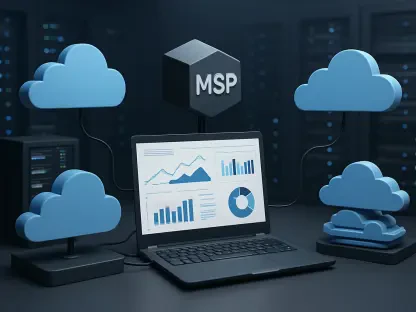Infrastructure as a Service (IaaS) is revolutionizing the cloud computing landscape, providing businesses with unprecedented flexibility, scalability, and cost efficiency. In this article, we delve into how IaaS empowers organizations to innovate faster, scale effortlessly, and navigate digital transformation.
The Basics of IaaS
Definition and Importance
IaaS delivers virtualized computing resources over the internet, offering essential infrastructure components such as virtual machines, storage solutions, and networking capabilities. This pay-as-you-go model eliminates the need for significant upfront investments in physical hardware, making it an attractive option for businesses of all sizes. By providing virtualized hardware resources on a rental basis, IaaS allows businesses to dynamically scale their IT capabilities in response to fluctuating demands, thus ensuring optimal cost efficiency and resource utilization.
Moreover, IaaS provides an agile environment where organizations can quickly develop, test, and deploy new applications and services without the constraints imposed by traditional IT infrastructures. For startups and enterprises alike, this means faster time-to-market, lower risk, and the ability to pivot and adapt to market changes with minimal friction. The infrastructure’s intrinsic flexibility makes it indispensable for companies aiming to remain competitive in a fast-evolving digital landscape. Businesses can thus redirect their focus to core competencies, leaving the complexities of infrastructure management to cloud service providers.
Contrast with Other Cloud Models
Understanding the differences between IaaS, PaaS (Platform as a Service), and SaaS (Software as a Service) is crucial for organizations looking to leverage the cloud effectively. IaaS provides the highest level of control over the IT environment, enabling businesses to manage their applications, data, runtime, middleware, and operating systems, while the infrastructure provider manages the virtualization, storage, networking, and servers. This model is ideal for businesses that need a customizable environment but do not want to invest in physical hardware.
In contrast, PaaS offers ready-to-use platforms for application development, eliminating the need for businesses to manage underlying hardware and software. PaaS solutions provide development tools, database management systems, and other resources, enabling developers to focus solely on coding and deploying applications. This model is particularly beneficial for developers who want to streamline the app creation process without worrying about infrastructure maintenance. SaaS, on the other hand, delivers fully managed software applications accessible via the internet, with minimal configuration requirements for end-users. SaaS solutions are ideal for businesses seeking to quickly deploy applications like CRM, ERP, or email without the burden of managing the infrastructure or platform.
Business Benefits of IaaS
Speed and Agility
One of the most compelling advantages of IaaS is its ability to enable rapid deployment and scaling of IT resources, providing businesses with the agility to respond quickly to market changes and customer demands. This flexibility is particularly beneficial for startups and growing enterprises, allowing for seamless expansion without the delays associated with physical hardware procurement. With IaaS, companies can quickly provision and decommission resources as needed, thus ensuring that IT capabilities align with business needs in real-time.
This dynamic scalability translates to faster time-to-market, as development teams can rapidly develop, test, and deploy new applications and services without waiting for additional hardware. Additionally, IaaS providers often offer a global network of data centers, allowing businesses to deploy resources closer to their customer bases, thereby reducing latency and improving performance. This global reach is especially advantageous for companies with diverse geographic footprints, enabling consistent and reliable service delivery across different regions.
Cost Efficiency
The pay-as-you-go model central to IaaS drastically reduces the need for hefty capital expenditures. Businesses can allocate their financial resources more effectively, paying only for the resources they use. By eliminating the need for large upfront investments in physical infrastructure, organizations can free up capital for other strategic initiatives, such as research and development or market expansion. This model also lowers operational costs related to maintenance, energy consumption, and IT personnel, further enhancing the overall cost efficiency of IaaS.
Moreover, IaaS providers often offer advanced monitoring and management tools that enable businesses to optimize resource usage and minimize waste. For instance, organizations can dynamically scale resources up or down based on real-time demand, ensuring that they only pay for what they actually use. This level of granular control over IT expenditures is particularly valuable for businesses with fluctuating workloads, as it allows them to maintain cost efficiency without compromising performance. Additionally, many IaaS providers offer tiered pricing models that cater to different usage patterns and business needs, making it easier for companies to budget and forecast their IT expenses.
Addressing Challenges in IaaS Migration
Mindset and Skill Shift
Transitioning from traditional IT systems to a dynamic cloud environment requires significant changes in capacity planning and application design. Organizations must rethink their approach to infrastructure management, moving away from static, siloed systems toward a more fluid, integrated model. This shift often necessitates a reevaluation of existing workflows, policies, and procedures to ensure that they align with the elastic nature of cloud computing. Furthermore, businesses must invest in training and upskilling their IT workforce to effectively manage and optimize IaaS environments.
Developing the necessary skills and expertise to manage IaaS effectively is another critical aspect of a successful migration. IT staff need to become proficient in cloud architecture, security best practices, and modern application development methodologies, such as DevOps and Continuous Integration/Continuous Deployment (CI/CD). Additionally, businesses may need to hire or contract cloud specialists to bridge any skill gaps and ensure a smooth transition. This emphasis on continuous learning and adaptation is essential for organizations to fully realize the benefits of IaaS and stay competitive in a rapidly evolving digital landscape.
Security Concerns and Integration Issues
Handling sensitive data in the cloud necessitates stringent security protocols and regulatory compliance. Businesses must ensure that their chosen IaaS provider offers robust security measures, such as encryption, identity and access management, and regular security audits, to protect against data breaches and other cyber threats. Additionally, organizations must implement their own security policies to complement the provider’s efforts and ensure comprehensive protection of their assets. This includes adopting a multi-layered security approach, conducting regular vulnerability assessments, and staying abreast of the latest security threats and trends.
Ensuring smooth integration between cloud resources and on-premises systems can present challenges, making it essential for businesses to adopt effective integration strategies. Hybrid cloud environments, where some workloads run in the cloud while others remain on-premises, require seamless connectivity and interoperability to function effectively. This often involves using middleware, APIs, and other integration tools to bridge the gap between different systems and ensure that data flows smoothly across the infrastructure. Additionally, businesses must establish clear governance and compliance frameworks to manage data privacy, regulatory requirements, and operational integrity in a hybrid environment.
Emerging Trends in IaaS
AI and Machine Learning Integration
AI and machine learning (ML) services integrated with IaaS are transforming how businesses process and analyze data. These advanced technologies enable automation and sophisticated data analysis, reducing the need for significant upfront investments and fostering innovation. With AI and ML capabilities readily available through IaaS platforms, businesses can leverage powerful tools to gain insights, optimize operations, and enhance customer experiences. For example, companies can use ML algorithms to analyze large datasets, identify patterns, and make data-driven decisions in real time.
Additionally, IaaS providers are increasingly offering pre-trained AI models and frameworks, lowering the barrier to entry for businesses looking to adopt these technologies. These ready-to-use models can be easily integrated into existing applications and workflows, accelerating the development and deployment of AI-powered solutions. For instance, organizations in industries such as healthcare, finance, and retail can utilize AI and ML to improve patient care, detect fraud, and personalize customer interactions, respectively. By leveraging the advanced analytics and automation capabilities provided by AI and ML, businesses can drive innovation and maintain a competitive edge in their respective markets.
Edge Computing
Expanding IaaS capabilities to the edge allows for data processing and real-time application execution closer to end-users. This is particularly crucial for IoT devices and autonomous systems, reducing latency and enhancing performance. By processing data nearer to the source, edge computing can minimize the time it takes for information to travel, resulting in faster response times and more efficient operations. This localized processing is especially important for applications that require real-time decision-making, such as autonomous vehicles, industrial automation, and smart cities.
Furthermore, edge computing enables businesses to optimize their cloud resources by offloading certain tasks to edge devices, thereby reducing the load on central data centers and improving overall system efficiency. This decentralized approach also enhances data privacy and security, as sensitive information can be processed and stored locally, minimizing the risk of exposure during transmission. As the number of connected devices continues to grow, the demand for edge computing solutions is expected to rise, making it an integral component of the modern IaaS landscape.
Advanced Innovations and Strategies
Serverless Computing
Serverless computing is gaining traction, allowing businesses to run code without managing servers. This reduces operational overhead and streamlines development processes, making it easier for developers to focus on building applications rather than managing infrastructure. In a serverless architecture, cloud providers automatically allocate resources and handle scaling based on the application’s needs, enabling businesses to achieve greater agility and efficiency. This model is particularly well-suited for event-driven applications, microservices, and other use cases where dynamic scaling and rapid deployment are paramount.
One of the key benefits of serverless computing is its cost-effectiveness. Since businesses only pay for the actual compute time consumed by their code, there are no costs associated with idle resources. This pay-per-execution model ensures optimal resource utilization and helps organizations manage their IT budgets more effectively. Additionally, serverless architectures can accelerate development cycles by allowing teams to focus on writing code and delivering features without the complexities of infrastructure management. As a result, businesses can bring new products and services to market faster, driving innovation and staying ahead of the competition.
Multi-Cloud and Hybrid Cloud Strategies
Adopting multi-cloud and hybrid cloud strategies helps businesses avoid vendor lock-in and optimize costs by leveraging the strengths of various cloud providers. These strategies offer greater flexibility and resilience, ensuring uninterrupted operations and improved performance. In a multi-cloud environment, organizations use services from multiple cloud providers to meet different needs, such as combining the cost efficiency of one provider with the advanced analytics capabilities of another. This approach allows businesses to choose the best solutions for their specific requirements while minimizing dependencies on a single vendor.
Hybrid cloud strategies, on the other hand, involve integrating on-premises infrastructure with cloud services to create a seamless, unified environment. This model provides the benefits of both cloud and on-premises systems, such as the scalability and flexibility of the cloud combined with the control and security of local data centers. Hybrid clouds are particularly useful for businesses with legacy systems or regulatory requirements that necessitate data residency. By adopting a hybrid approach, organizations can optimize their IT infrastructure, improve agility, and ensure compliance with industry standards.
Focus on Sustainability
Infrastructure as a Service (IaaS) is transforming the cloud computing landscape, offering businesses unparalleled flexibility, scalability, and cost-efficiency. By providing virtualized computing resources over the internet, IaaS allows organizations to innovate faster, scale operations effortlessly, and manage their digital transformation with ease. Essentially, companies can access and pay for only what they need, avoiding the hefty costs and complexity of maintaining physical hardware.
One of the key benefits of IaaS is its scalability. Businesses can quickly adjust their infrastructure requirements to meet demand, whether that means scaling up during peak periods or down during quieter times. This flexibility is crucial in a world where market conditions and customer needs can change rapidly. Moreover, IaaS enables organizations to experiment and develop new projects without the risk of significant upfront investments.
Another significant advantage is cost efficiency. Since companies only pay for the resources they use, there are considerable savings on capital and operational expenditures. This model allows businesses to allocate their resources more effectively, fostering a flexible and budget-friendly approach to growth.
Additionally, IaaS supports digital transformation by providing a robust infrastructure that can handle various applications and workloads. Companies can focus on developing their core business activities instead of worrying about IT infrastructure. In this article, we explore how IaaS empowers organizations, helping them innovate quicker, scale seamlessly, and transition smoothly to the digital age.









